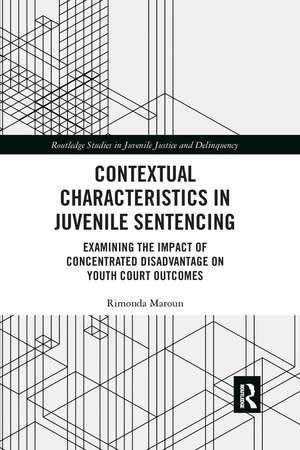Contextual Characteristics in Juvenile Sentencing: Examining the Impact of Concentrated Disadvantage on Youth Court Outcomes: Routledge Studies in Juvenile Justice and Delinquency
Autor Rimonda Marounen Limba Engleză Paperback – 31 mar 2021
Using case-level data from a Southern state with a large, diverse population and contextual-level data from the 2010 US Census and American Community Survey, Maroun assesses whether youth living in neighborhoods of concentrated disadvantage experience harsher outcomes than their counterparts from other types of neighborhoods. Additionally, she examines whether concentrated disadvantage interacts with individual race/ethnicity to influence juvenile court outcomes. Results suggested a direct impact of concentrated disadvantage on diversion, adjudication, and probation type. Further, race significantly interacted with concentrated disadvantage in impacting adjudication and probation outcomes, while ethnicity significantly interacted with concentrated disadvantage in impacting disposition and commitment type.
This research expands the knowledge of macrolevel influences on juvenile court outcomes, providing support for the notion that community context impacts juvenile justice processing. Results also highlight the fact that judges use discretion as well as other legal and extralegal factors in exerting social control, and do so differently at each stage of processing. This monograph is essential reading for those engaged in youth and juvenile justice efforts and scholars interested in issues surrounding race, class, social policy, and justice.
| Toate formatele și edițiile | Preț | Express |
|---|---|---|
| Paperback (1) | 360.14 lei 6-8 săpt. | |
| Taylor & Francis – 31 mar 2021 | 360.14 lei 6-8 săpt. | |
| Hardback (1) | 1154.29 lei 6-8 săpt. | |
| Taylor & Francis – 28 feb 2019 | 1154.29 lei 6-8 săpt. |
Preț: 360.14 lei
Preț vechi: 379.09 lei
-5% Nou
Puncte Express: 540
Preț estimativ în valută:
68.91€ • 71.81$ • 57.06£
68.91€ • 71.81$ • 57.06£
Carte tipărită la comandă
Livrare economică 03-17 aprilie
Preluare comenzi: 021 569.72.76
Specificații
ISBN-13: 9780367530235
ISBN-10: 0367530236
Pagini: 146
Ilustrații: 14
Dimensiuni: 152 x 229 x 10 mm
Greutate: 0.2 kg
Ediția:1
Editura: Taylor & Francis
Colecția Routledge
Seria Routledge Studies in Juvenile Justice and Delinquency
Locul publicării:Oxford, United Kingdom
ISBN-10: 0367530236
Pagini: 146
Ilustrații: 14
Dimensiuni: 152 x 229 x 10 mm
Greutate: 0.2 kg
Ediția:1
Editura: Taylor & Francis
Colecția Routledge
Seria Routledge Studies in Juvenile Justice and Delinquency
Locul publicării:Oxford, United Kingdom
Cuprins
Introduction “Kids Count:” The Nature and Extent of Children Living in Poverty; 1. Juvenile Justice Processing: Historical and Present Procedures; 2. Blind Justice? An Empirical Review; 3. Digging the Groundwork: Theoretical Constructs; 4. Examining the Impact of Concentrated Disadvantage on Juvenile Sentencing Outcomes: Methodology; 5. Does Concentrated Disadvantage Matter? Assessing Results; 6. Breaking it Down: Summarizing and Discussing Results; 7. Looking to Tomorrow: Policy Implications and Directions for Future Research
Notă biografică
Rimonda Maroun is Assistant Professor of Criminal Justice at Endicott College. Maroun earned her PhD in Criminology and Justice Studies and MA from the University of Massachusetts at Lowell, and graduated from Saint Anselm College with a BA in Criminal Justice with concentrations in Forensics and Spanish. Her research interests include juvenile justice policy and practice, race and ethnicity and justice, sentencing, offender re-entry, and quantitative methodology. Maroun previously worked as a research assistant for the Massachusetts Child Welfare and Juvenile Justice Leadership Forum, which does research with police and social service agencies on which juvenile diversion programs are most effective and promote positive youth development.
Descriere
Contextual Characteristics in Juvenile Sentencing assesses how a specific contextual factor—concentrated disadvantage—impacts juvenile court outcomes and considers the relevant implications for the current state of juvenile justice processing.





